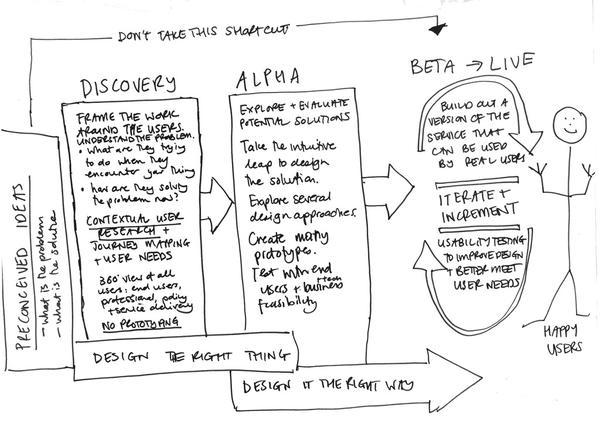1. An introduction to Discovery
Discovery is the first stage of the service design and delivery process.
The purpose of Discovery is to help the team get an understanding of the problems they are setting out to address in the service by understanding:
- what people are really trying to do when they encounter your service (eg. planning to travel abroad, not just get a passport),
- what the current experience is for users, and
- what their needs are as they interact with the service.
You’ll examine all the channels and touchpoints of the service (not just digital); the end-to-end experience, and key user groups including end users, professional users, public servants supporting service delivery and policy users, even if you are only planning to focus on a small part of that experience. You should achieve this by doing contextual user research that involves the entire team.
The Discovery stage will help the team to challenge their preconceived ideas of what the problem and solution might be and to frame their understanding of problem and solution around the user’s experience.
In the Discovery phase you’ll clarify the government’s policy intent for the service so that you are able to align the policy intent with user needs.
You’ll need to understand how the service is currently being delivered, looking at the existing business processes, the technology that supports them, and how data flows through the service. It’s important to note that this is not the same as user experience mapping.
If there are any obvious technical, legislative or other constraints relating to the service these should be noted in the discovery phase too.
1.0.1. What discovery is not
Discovery is not about prototyping and testing: you’ll do this during the Alpha stage.
Discovery is not about looking at only a single system or interaction - it has to look at the broader view of the whole service. You should aim to understand the intent of the user and their journey leading up to their interaction with the service, where they have come from and where they are heading next.
Discovery is not about validating ideas you already have about the problems and the solutions for your project.

1.0.2. The duration of discovery
There’s no one-size-fits-all duration for a Discovery, however, many teams spend between four and six weeks.
It’s important that the team can commit their full-time to the Discovery, and not be split with other projects. When setting up the team, you should aim to retain the same team members (in the same roles) throughout all Service Design and Delivery phases. The intent of this it to provide continuity and to ensure the successful delivery of service.
1.0.3. The roles needed
The team needs the following roles:
- a service manager
- a product manager
- a delivery manager
- at least one user researcher and one service designer in the team - ideally more
- a technical architect
Some projects may also need:
- a business analyst
- a performance analyst
- an information architect
Support from subject matter experts and other stakeholders throughout the Discovery is also a lot of help.